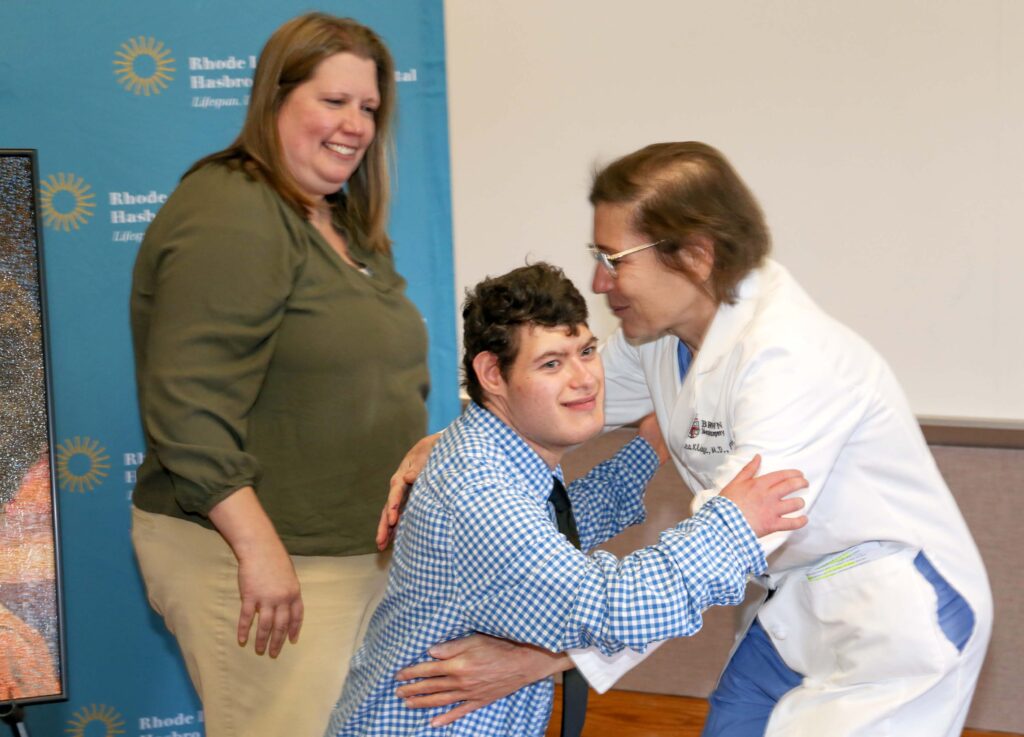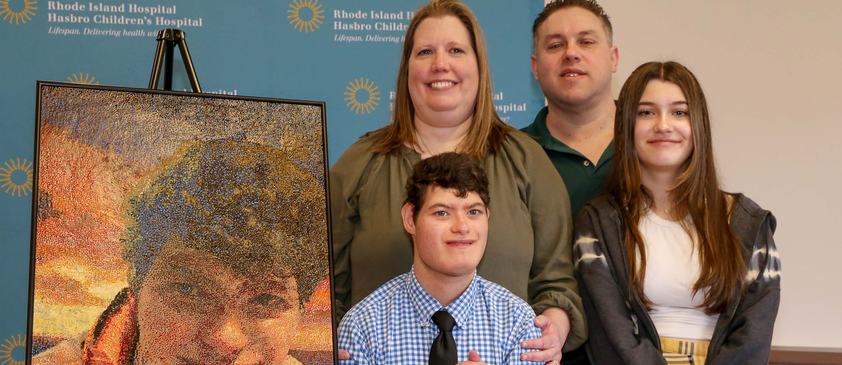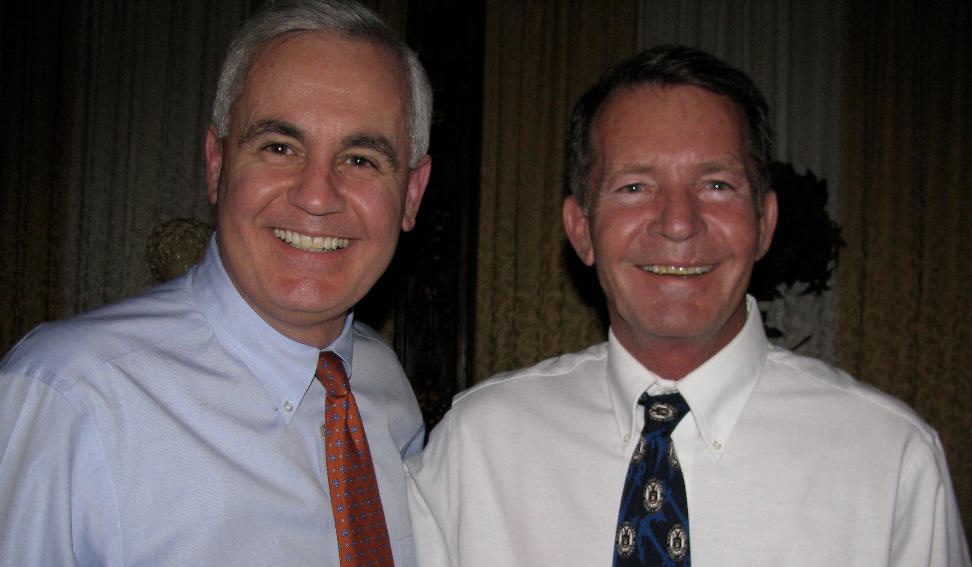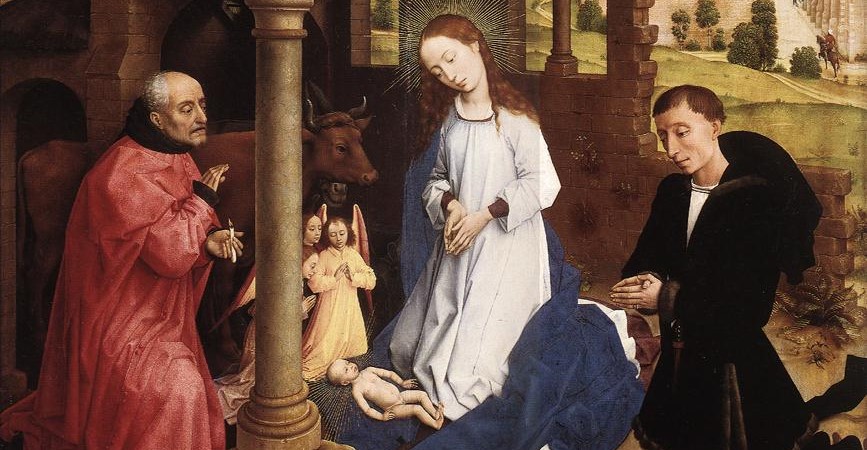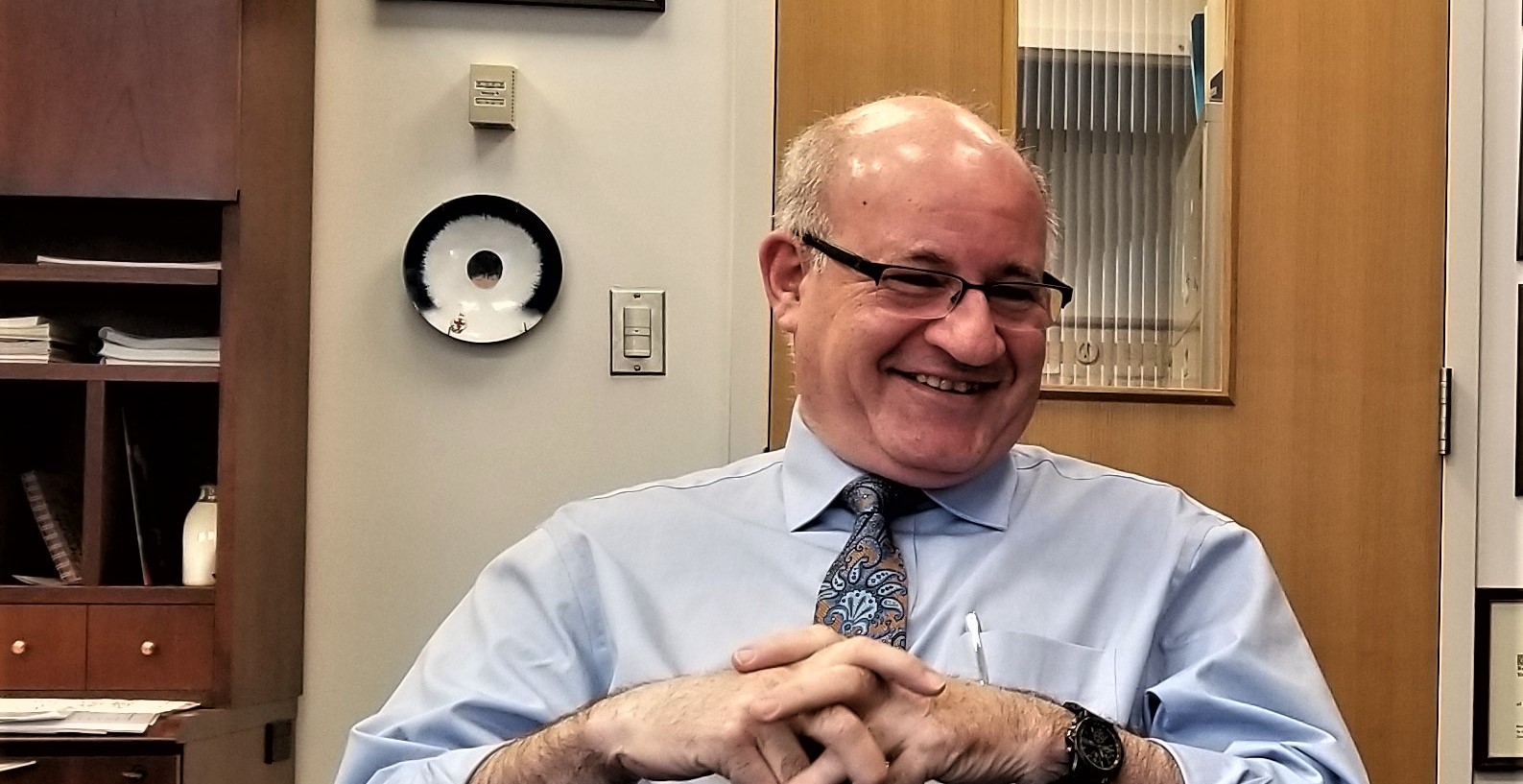How Hasbro Children’s Hospital and a non-profit organization, Beyond the Diagnosis, help a young Rhode Islander and others living with rare diseases
PROVIDENCE — When Logan Brown was born prematurely, he weighed less than a pound. “The doctors didn’t give us much hope that he would live,” says his mother, Elsbeth.
Now age 19, Logan is full of life. Despite the many challenges he has faced over the years, he is thriving, popular with classmates, and even a bit of a celebrity. A specially commissioned portrait of Logan is part of an art exhibit at Hasbro Children’s Hospital that runs through the end of February. Afterwards, Logan’s portrait will become part of larger collection exhibited at other venues.
When his portrait was unveiled at Hasbro Children’s Hospital in November, Logan celebrated the moment with his entire family. In addition to his mother, Elsbeth, he was joined by his father Jeremy and his younger sister Catherine. The family lives in East Providence.
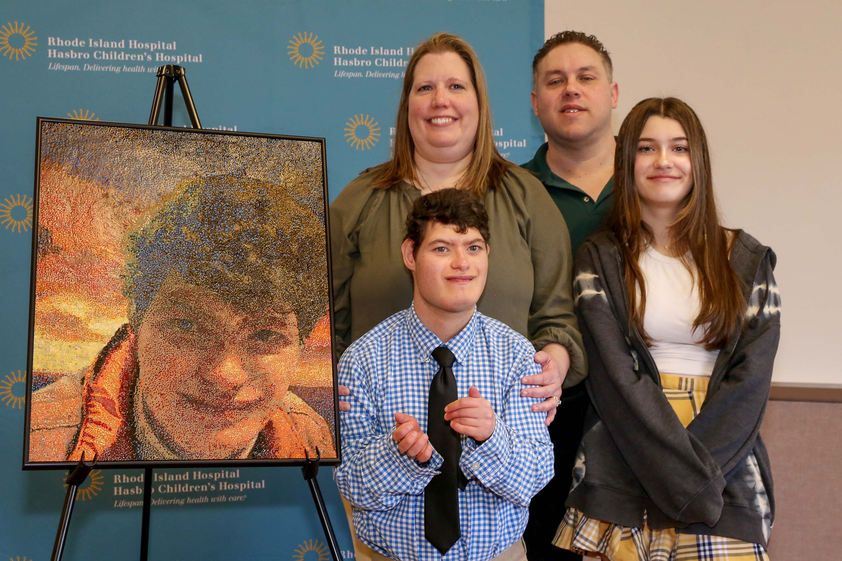
Logan’s portrait was commissioned by Beyond the Diagnosis, a nonprofit organization whose mission is to emphasize the humanity of people who have rare diseases. The portraits enable viewers to look beyond disabilities and instead see a fellow human being. Funding is provided by corporations and individual donors.
Patricia Weltin of Rumford founded Beyond the Diagnosis after both her daughters were diagnosed with Ehlers Danlos syndrome, which affects connective tissues that support the skin, bones, and many organs and tissues. This can cause problems such as loose joints, weak muscle tone, and fragile skin.
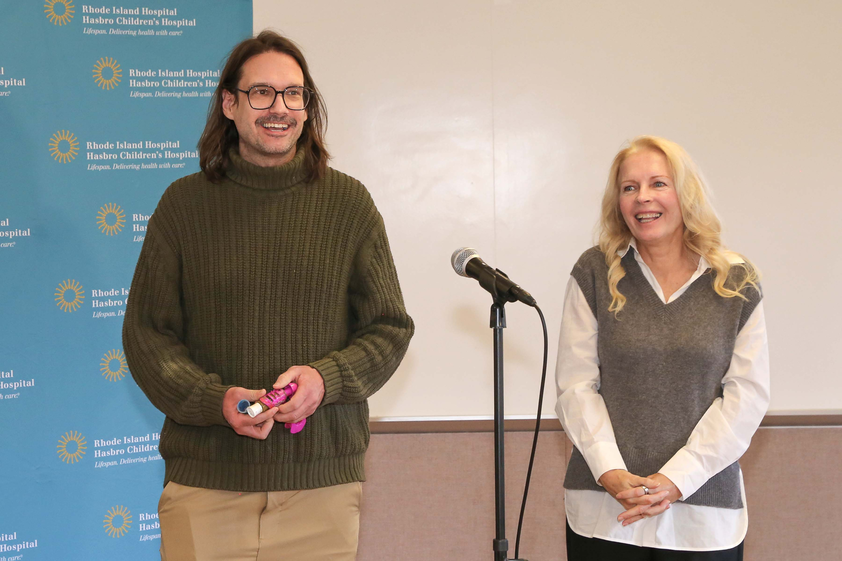
Initially the organization focused on mounting exhibits in American hospitals and medical schools. “I wanted to use art in a way that would help doctors and others see beyond the diagnosis and see these kids as humans,” Weltin explains. The first two exhibits took place in 2015 at the Warren Alpert Medical School at Brown University and Harvard Medical School. As time went on, the organization began mounting art exhibits at other venues, such as the Food and Drug Administration, rare disease film festivals, and public events geared towards inclusion. Several exhibits have taken place overseas.
In addition to the exhibit at Hasbro Children’s Hospital, Beyond the Diagnosis has also mounted one at Brown’s medical school that runs through February. Later this year, it will organize exhibits at Rhode Island College, the National Institutes of Health, Arkansas Children’s Hospital, and Children’s Hospital of Richmond, Virginia.
“We’re also creating an exhibit specifically for Africa,” Weltin says. “Next we want to create one for Latin America and another for Europe.”
Rare diseases really aren’t so rare. About 30 million people in the United States—nearly one in 10—have a rare disease, according to the FDA. The Orphan Drug Act defines a rare disease as one that affects fewer than 200,000 people in the United States. More than 7,000 rare diseases have been identified so far. These include some that may be familiar, such as Huntington’s disease, amyotrophic lateral sclerosis (also known as Lou Gehrig’s disease), and muscular dystrophy. Others are so rare they are not well known.
Patients with rare diseases often go for years without a diagnosis, see multiple medical experts, and struggle to live with disorders that lack treatments. It’s an experience Logan knows all too well.
He was born with microcephaly, a smaller-than-normal head. Babies with microcephaly usually have brains that have not developed normally, or stopped growing, during pregnancy. As a result, Logan has faced developmental challenges. For instance, he didn’t learn to walk until he was four years old. He also has coped with other challenges, among them profound deafness and kidney and thyroid problems. Doctors have told the Browns that Logan most likely has a rare genetic condition known as Warsaw syndrome. There are only 14 cases of this syndrome documented worldwide in the medical literature.
His parents have their own name for Logan’s condition. “We just say he has Logan Brown syndrome,” says Elsbeth. “And he’s awesome.”
Through the years, they have supported Logan and encouraged him to live up to his full potential.
Then something happened that threatened Logan’s progress. “Logan always had a gait that was off,” Elsbeth says. “We attributed that to his birth and his journey. But in 2019 his gait really started to change. He was quickly losing his ability to walk. It was really scary.”
Elsbeth and Jeremy took Logan to multiple specialists in Rhode Island, but nobody could figure out what was wrong. The family even traveled to Boston, but doctors there were stumped as well.
“It was tough for all of us,” Jeremy says. “MRIs, X-rays, everything was negative. The answer was always, ‘We don’t know.’ And Elsbeth and I didn’t know what to do.”
That changed when Logan’s pediatrician referred them to Dr. Petra Klinge, director of pediatric neurosurgery at Hasbro Children’s Hospital.
“In her nice calm way,” Jeremy says, “Dr. Klinge said, ‘It’s my job to figure this out.’ ”
“I cried, because I knew she was our last hope,” says Elsbeth.
Logan’s spirit impressed Klinge. “I could see that this young man was up to something great in his life, no matter what,” she says. The challenge was to identify what was impeding his ability to walk.
“When I first became involved in taking care of patients with complex conditions, I immediately learned that I have to go outside the box. Leave the territory of medical textbooks and listen to symptoms,” Klinge says. “I knew that we needed to dig into the invisible. No test, not even a brain or spine MRI, helped us to understand what was going on and why he was losing so much function so rapidly.”
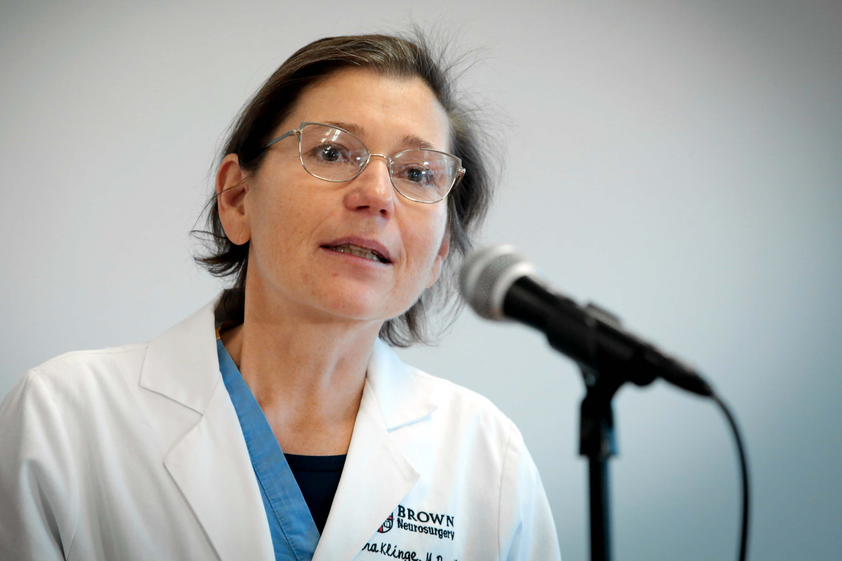
“His parents were the greatest advocates,” Klinge says. “Not only where they there to tell me that they don’t accept the disabilities that Logan was facing, but they also helped us to be comfortable with treating Logan, to take on this challenge.”
After reviewing Logan’s symptoms and previous tests, Klinge did a physical examination. “I could feel something in Logan’s legs that made me understand that his spinal cord was stuck somewhere,” she says. Klinge concluded that Logan had a tethered spinal cord, which occurs when surrounding tissue attaches itself to the spinal cord. This can limit the ability of the spinal cord to move properly, causing nerve damage, back pain, and weakness in the legs. Klinge told Jeremy and Elsbeth that surgery was necessary to fix the problem and enable Logan to walk again.
Time was of the essence. “When we met with Dr. Klinge, it got to the point that Logan couldn’t stand,” Jeremey says. “When we told her that, she said, ‘You need to admit him to the hospital right now.’ We had one to two weeks. If we didn’t have the surgery in that time, even if surgery was successful, we wouldn’t be standing here today.”
Klinge performed surgery to untether Logan’s spinal cord. Afterwards, he underwent months of physical therapy. He gradually went from using a wheelchair, to a walker, and finally to walking again on his own.
“If it wasn’t for Dr. Klinge operating when she did, I don’t think he’d ever walk again, because his nerves were so damaged,” says Jeremy. “We’re very thankful to Dr. Klinge and the team at Hasbro Children’s Hospital. Logan wouldn’t be standing here today if it wasn’t for her.”
Logan added his own observation. “Now I’m independent,” he signed.
Patricia Weltin also praised Klinge, who had earlier performed tethered cord surgery on one of her daughters. “When you have a child whose condition is complicated, and it’s a multisystemic disease, you see a lot of doctors,” Weltin says. “To have a doctor listen to you instead of talk at you, and make you part of the process, is huge. My experience with Petra was extraordinary.”
Local artist Lucas Kolasa painted Logan’s portrait. One of the first artists to volunteer for Beyond the Diagnosis, Kolasa got involved when someone at the Wickford Art Association called him one day. They told him about Weltin and her new organization. “They asked if I’d be interested in helping her out,” Kolasa says. He has now done six portraits for the organization.
“It was an honor to paint Logan,” Kolasa says. He worked from photographs of Logan and asked Jeremy and Elsbeth for details about his personality. “I asked questions like, what is his favorite color? What are his interests? Things like that. So then I have some idea of who he is and then I work from there.”
“When I painted him, I felt a real connection to him,” Kolasa says. At the unveiling ceremony, he learned there may be a reason for that: he and Logan share the same birthday.
When he paints portraits, Kolasa uses a technique known as pointillism. This involves creating an image by filling the canvas with a series of small, distinct dots. Normally he paints with brushes or syringes. “I have special tapered tips so I’ll pluck out one dot at a time,” he says.
But this time he tried something different. “Since this was for Hasbro Children’s Hospital,” Kolasa says, “I decided to use a DohVinci toy made by the Hasbro Toy Company.”
The toy’s styling tool resembles a squirt gun. A modified form of Play-Doh fills tubes that are inserted into the styling tool. “I modified the toy so that I could fill the tubes with paint instead of Play-Doh,” Kolasa says. “Then I squeezed out one dot at a time.”
When the portrait was unveiled, Logan recognized himself immediately. He signed, “That’s me.” And then he broke into a huge grin. His classmates, who traveled from the Rhode Island School for the Deaf to attend the unveiling, were all smiles as well.
Before Logan was born, Elsbeth worked as an early childhood teacher. Now she works at the Rhode Island School for the Deaf. “When he received his diagnosis of deafness, that brought a whole new journey to my life of advocating for hearing screening and for children getting follow up and learning sign language,” she says. “I work at his school, but I also do hearing screenings at all schools in the state. I love it. I think his deafness has been such a blessing in disguise.”
“We’re very thankful,” Elsbeth says. “Logan is an amazing kid.”
